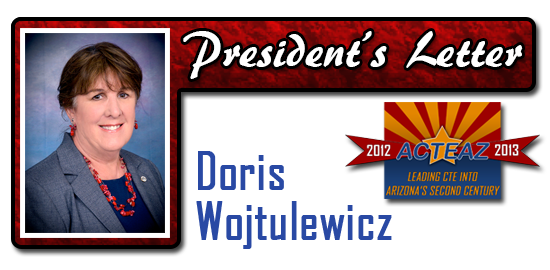
According to John A. Daly1, “advocacy means persuading people who matter to care about your issue”. Using this definition, we in CTE have been very busy advocating these last weeks. February was CTE Month. Excellent campaigns, activities and efforts were made across Arizona and the nation to market the value of Career and Technical Education. In March delegations from almost every state, including our own, traveled to Washington D.C. to “Climb the Hill”. Armed with facts, figures and success stories, we met with each of our members of Congress to encourage them to recognize the crucial role CTE plays in our schools and in our workforce and to therefore continue to support and fund our programs. And now CTE Month is over and NPS is over. What happens next? We turn our sights on ending the school year, of course. There is so much to be done this time of year. We advocated and now we have other very important things to do. Right?
I have attended National Policy Seminar for a long time now. It’s a wonderful experience (I would encourage every one of you to attend at least once). Not only do we “walk the Halls of Congress” and participate first hand in our democratic process, we are exposed to a plethora of experts in all phases of CTE, Education and Labor who help us strengthen our advocacy. These speakers generally make us feel good about what we do. But I remember one speaker several years ago. She welcomed us. She smiled. And then she said that CTE was NOT effective, no one was listening to us, and it was OUR fault. She didn’t say it in a nice way. I was surprised. I was insulted. I was mad. In fact, I was very mad because she was wrong. She obviously didn’t understand how hard we all worked. She said we weren’t doing a good job of selling the value of what we do and as long as we continued working in the same way, nothing would change. I left determined to prove her wrong. I studied all night and the next day when we climbed the Hill, I was ready. I was good. I was armed with facts and figures. I advocated strongly and confidently, maybe even eloquently. And then I went home… and finished the school year. I had so many important things to do.
So, here we are again. CTE Month is over. NPS is over. The end of the school year is looming. These things are true. What we must recognize is that none of these facts mean that our advocacy is also over. John Daly also says, “wise advocates know they must keep selling long after an idea is launched”. This is when, despite all the other important things we have to do, we must keep advocating. One thing was said this year at NPS that I think bears repeating. Assistant Secretary Jane Oates of the U.S. Department of Labor Employment and Training Administration said that one thing we needed to remember as we advocated is that government and policy makers are inundated with facts, figures and statistics. She said the most important thing we can do as advocates is give those numbers a face. So, if you are wondering how you can advocate now, this is how. Invite policy makers to visit your programs. This is the best time of year for that. Your students are at their best because you have been teaching them all year. Administrators, your teachers are amazing. Let’s end the school year by giving a face to CTE. Tell your success stories. Show off your programs, your teachers, and your students. Actually invite your Congressman or Legislator or a School Board member to visit you. Ask a business partner to visit or a business CEO. You will be surprised how many will accept and how receptive they will be to your message. Don’t stop now.
As I have said before, I believe this is an unprecedented time for CTE. Recent events in our economy and public education have given us an opportunity like none that I can remember to step forward and validate the value of CTE. CTE is a vital part of our recovery. It is also important for me to note that there are individuals in Arizona that have exemplified the very best in CTE advocacy. It is impossible to name them all here, but please know that they have been instrumental in assuring that CTE is at the table as the important issues facing our State are addressed and they have been active participants in the development of new strategies and solutions. All of us, as CTE professionals, owe them a debt of gratitude. I would like to take this opportunity to thank them for their hard work. I would like to encourage you to help them. Continue to be an advocate or become one. Do your part. We can’t drop the ball now. Put a face on CTE because… CTE Works!
Footnote: 1 John A. Daly is the author of Advocacy: Championing Ideas and Influencing Others. ACTEAZ Fellows are using this as their book study this year.
ACTE, our national association, continually advocates for CTE in Washington D.C. By joining ACTE you strengthen the voice of CTE as important policy/funding decisions are being made. If you are interested in policy, ACTE provides important Legislative Updates to keep you informed and to notify you when your advocacy can help with a particular issue. Their website is at www.acteonline.org. Click on Policy & Advocacy at the bottom of the page to access the latest information on critical issues, what is being done and how you can help.